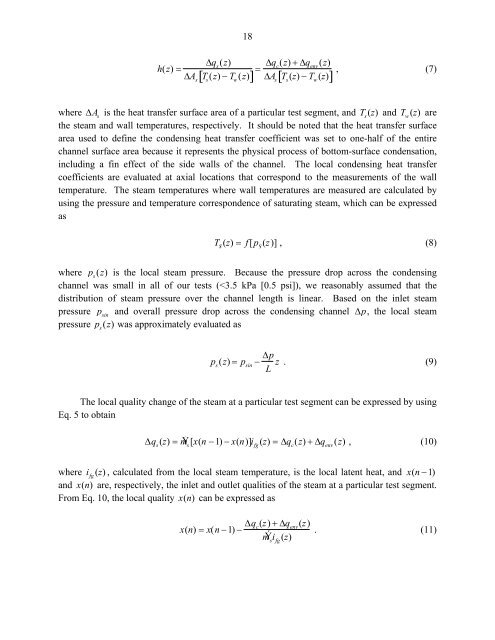final report on the multiport dryer - Argonne National Laboratory
final report on the multiport dryer - Argonne National Laboratory
final report on the multiport dryer - Argonne National Laboratory
You also want an ePaper? Increase the reach of your titles
YUMPU automatically turns print PDFs into web optimized ePapers that Google loves.
18∆qh(z) =s(z)∆A s [ T s(z) − T w(z)] = ∆q (z) + ∆q (z)c env∆A sT s(z) − T w(z)[ ] , (7)where ∆ A sis <strong>the</strong> heat transfer surface area of a particular test segment, and T s(z) and T w(z) are<strong>the</strong> steam and wall temperatures, respectively. It should be noted that <strong>the</strong> heat transfer surfacearea used to define <strong>the</strong> c<strong>on</strong>densing heat transfer coefficient was set to <strong>on</strong>e-half of <strong>the</strong> entirechannel surface area because it represents <strong>the</strong> physical process of bottom-surface c<strong>on</strong>densati<strong>on</strong>,including a fin effect of <strong>the</strong> side walls of <strong>the</strong> channel. The local c<strong>on</strong>densing heat transfercoefficients are evaluated at axial locati<strong>on</strong>s that corresp<strong>on</strong>d to <strong>the</strong> measurements of <strong>the</strong> walltemperature. The steam temperatures where wall temperatures are measured are calculated byusing <strong>the</strong> pressure and temperature corresp<strong>on</strong>dence of saturating steam, which can be expressedasT s (z) = f [p s (z)] , (8)where p s(z) is <strong>the</strong> local steam pressure. Because <strong>the</strong> pressure drop across <strong>the</strong> c<strong>on</strong>densingchannel was small in all of our tests (
















